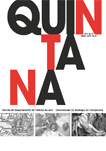Núm. 16 (2017), Colaboraciones
Recibido: 10-10-2016
Aceptado: 23-04-2018
Publicado: 29-12-2018
One of the most compelling topics in the history of contemporary art today has to do with the empire-tourism binomial. Both are closely interconnected since colonisation was a driving force that led to a new mobility. Initially, the voyages of the Discoveries were restricted to conquest, missionisation and trade, but from the 19th century on travelling to the colonies became a political, social, cultural and artistic imperative. In fact, after the end of the 19th century, European imperial policy encouraged travel to the overseas possessions not only to (re)define their territory geographically but primarily as a reflection of the emerging European nationalisms, turning travel into a privileged means for legitimating the overseas provinces and for spreading propaganda about them. This meant that colonial tourism developed on various levels and on various fronts, promoting an overseas holiday experience that became a civilisational datum and a measure of contemporary culture.
Tourism, Empire, Art from Overseas, Travel, Colonial Heritage







